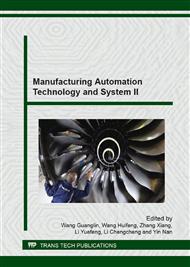[1]
R. J Zhang, F Lin and Yan Yongnian, et al: Our Country Rapid Tool Technology Development and Prospect, Chinese Journal of Mechanical Engineering metal processing, Vol. 8(2008), pp.62-64.
Google Scholar
[2]
Terry Wohlers: Wohlers Report 2012 (State of the Industry Annual Worldwide Progress Report), (2012).
Google Scholar
[3]
J Ya Lee, Member Cheng-Hsien, and Chung Yu-Ti Jhan: Mold-flow Analysis for Manufacturing FRP Structures in Vacuum Assisted Resin Transfer Molding. Conference Proceedings, Japan Society of Naval Architects and Ocean Engineers, (2006).
Google Scholar
[4]
Kurtaran H, Ozcelik B and Erzurumlu T: Warpage Optimization of a Bus Ceiling Lamp Base Using Neural Network Model and Genetic Algorithm, Journal of Materials Processing Technology , Vol. 169 (2005), pp.314-319.
DOI: 10.1016/j.jmatprotec.2005.03.013
Google Scholar
[5]
Y. H Gao, X. C Wang: Surrogate-Based Process Optimization for Reducing Warpage in Injection Molding, Journal of Materials Processing Technology, Vol. 3 (2009), No. 209. p.1302—1309.
DOI: 10.1016/j.jmatprotec.2008.03.048
Google Scholar
[6]
G. Q Xiang, Z. J Yan, D. G Huang: Genetic Optimization Design Based on Support Vector Regression Metamodeling, Journal of University of Electronic Science and Technology of China, Vols. 3 (2009) , No. 38, pp.459-462. (In Chinese).
Google Scholar
[7]
F. F LI, Y. K Zhao: The Least Squares Support Vector Machine Based on Matlab Toolbox and Its Application, Computer Applications, Vol. 12 (2006) , pp.358-360. (In Chinese).
Google Scholar
[8]
X. J Peng: On Issues and Applications for Support Vector Machine. (Ph.D., Shanghai University, China 2008), pp.31-43. (In Chinese).
Google Scholar
[9]
N. Y Deng, Y. J Tian: A Novel Method in Data Mining: Support Vector Machine (Science Press, China 2004), pp.77-86. (In Chinese).
Google Scholar
[10]
THEODORIDIS S, MAVROFORKIS M: Reduced convex hulls: a geometric approach to support vector machines, IEEE Signal Processing Magazine, Vol. 3(2007) No. 24, pp.119-122.
DOI: 10.1109/msp.2007.361610
Google Scholar
[11]
Fröhlich H, Chapelle O, Schölkopf B: Feature selection for support vector machines by means of genetical gorithms, Proceedings of 15th IEEE International Conference on Tools with Artificial Intelligence, Sacramento, California, USA, Vols. 3-5(2003).
DOI: 10.1109/tai.2003.1250182
Google Scholar
[12]
C. R Wang, C. L Zhou, J. W Ma: An Improved Artificial Fish-swarm Algorithm and its Application in Feed-forward Neural Networks, Proceedings of the Fourth International Conference on Machine Learning and Cybernetics, (2005).
DOI: 10.1109/icmlc.2005.1527436
Google Scholar


